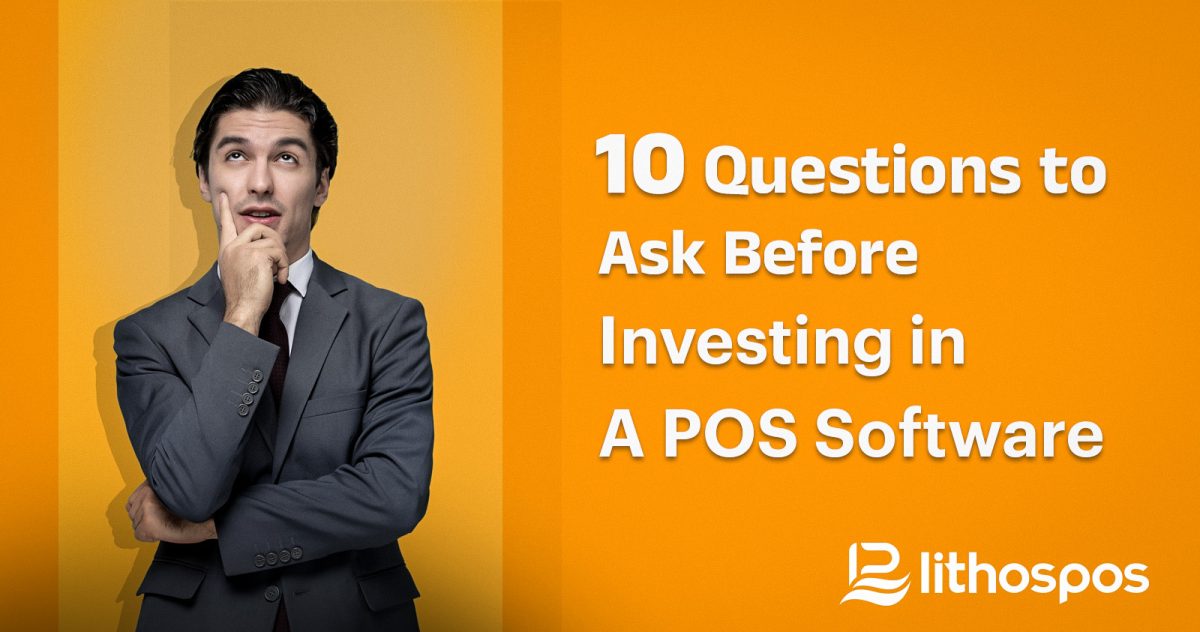Are You Facing Challenges Managing Your Supermarket?
Running a supermarket is not easy. Are you struggling with long checkout lines, inefficient inventory management, or customer satisfaction? According to a study by Statista, retailers that adopt advanced technology solutions have seen measurable increases in operational efficiency and customer retention rates.
Point of Sale (POS) software is a game-changing tool that addresses these challenges head-on. A robust POS solution like LithosPOS enables supermarkets to run smoothly, streamline processes, and increase overall performance.
Here’s a comprehensive look at how supermarkets can achieve unmatched efficiency with modern POS software.
1. Speeding Up the Checkout Process :
In every supermarket, the checkout experience is critical. Long queues and slow payment systems can frustrate customers and affect their shopping experience. POS software like LithosPOS solves this challenge by enabling lightning-fast transactions:
- Barcode Scanning: Simplify product identification with fast barcode scanning to ensure accurate pricing and faster checkout times.
- Integrated payment systems: Accept multiple payment methods, including credit and debit cards, mobile payments and digital wallets, making payments seamless.
- Self-service kiosks: Reduce reliance on cashiers and empower customers to complete transactions, reducing wait times.
With these features, supermarkets can reduce checkout bottlenecks, and increase customer satisfaction and overall efficiency.
2. Simplifying Inventory Management :
Supermarkets handle thousands of products across multiple categories, complicating inventory management. POS software simplifies this process
- Real-time tracking: Monitor inventory status in real-time to ensure products are always available.
- Low Stock Alerts: Receive automatic alerts for low-end items to prevent stock-outs.
- Sales Reports: Generate detailed reports on fast-moving and slow-moving items to help managers make informed purchasing decisions.
With LithosPOS, supermarkets can maintain optimized inventory, avoid overstocking, and reduce waste, ensuring smooth operations.
3. Enhancing Employee Productivity :
A user-friendly POS software can significantly improve employee efficiency and productivity
- Fast training: LithosPOS an all-in-one POS Software offers an intuitive interface that minimizes the time needed to train new employees.
- Role-based access: Assign specific roles and permissions to employees to ensure safe and efficient operations.
- Performance Monitoring: Track sales through detailed logs and analytics.
By simplifying everyday tasks, supermarkets can create a more engaged and efficient workforce.
4. Improving the Customer Experience :
Customer satisfaction is the foundation of a supermarket’s success. Modern POS software helps improve the shopping experience in several ways:
- Personalized Promotions: Use data insights to create tailored promotions and loyalty programs based on customer buying habits.
- Fast returns and exchanges: Manage returns and exchanges efficiently with digital receipts and transaction history.
- Multi-Lane Operations: Manage multiple checkout lanes to ensure smooth operations during peak shopping hours.
With LithosPOS, supermarkets can foster loyalty and encourage repeat business by consistently delivering exceptional customer experiences.
5. Optimizing Pricing and Promotions :
Supermarkets often rely on discounts and promotions to attract customers. Effective management of these offers is critical to profitability. POS software can
- Automate discounts: Set up time-sensitive promotions and bulk discounts right in the software.
- Centralized Updates: Implement price changes at all checkouts.
- Campaign Analytics: Measure the success of promotional campaigns and adjust strategies accordingly.
LithosPOS makes it easy to create and execute dynamic pricing strategies that drive customer engagement and increase sales.
6. Supporting Multi-Location Management :
For supermarkets with multiple locations, managing operations across locations can be challenging. POS software makes it easy:
- Centralized control: Monitor inventory, pricing, and promotions across all branches from a single platform.
- Warehouse moves: Facilitate the seamless movement of goods between locations to balance inventory.
- Consolidated reporting: Access sales and performance data for all branches, making it easy to track overall success.
LithosPOS is designed to support multi-site management and ensure consistent performance and operations across all stores.
7. Ensuring Uninterrupted Operations with Offline Compatibility :
Unplanned internet outages can disrupt supermarket operations. However, with POS offline functionality, supermarkets can:
- Continue transactions: Process sales and accept payments even when the internet is down.
- Automatic synchronization: Automatic synchronization of data after the connection is restored to avoid information loss.
The offline capabilities of LithosPOS provide peace of mind and allow supermarkets to operate without interruption.
8. Leveraging Actionable Insights :
POS software offers advanced analytics and reporting tools to help supermarkets make data-driven decisions:
- Sales Insights: Identify top-performing products and underperforming items to optimize inventory and marketing strategies.
- Customer trends: Analyze customer behavior to tailor promotions and improve service.
- Forecasts: Use historical data to forecast demand and prepare for seasonal trends.
With LithosPOS, supermarkets can unlock the power of data and gain insights that lead to smarter business decisions and greater efficiency.
Why Choose LithosPOS for Your Supermarket?
LithosPOS is more than just point-of-sale software; it is a comprehensive solution designed to meet the unique needs of supermarkets.
Here’s why LithosPOS stands out:
- Scalability: Whether you run a single store or a supermarket chain, LithosPOS adapts to your business.
- Device Compatibility: Compatible with a variety of hardware, including tablets, desktops, and mobile devices.
- Easy integration: Seamless connection with accounting software, payment gateways, and other third-party tools.
- Customizable features: Customize the software to meet the specific requirements of your supermarket.
- Reliable Support: Enjoy 24/7 customer support to ensure smooth operations at all times.
By choosing LithosPOS, supermarkets get a powerful tool that not only improves efficiency but also helps them stay ahead of the competitive market.

Conclusion –
Efficiency is the backbone of any successful supermarket. With the right tools, such as a robust POS software solution like LithosPOS, supermarkets can streamline their operations, improve customer experience, and drive overall growth.
By simplifying checkout processes, optimizing inventory management, increasing employee productivity and providing data-driven insights, LithosPOS helps supermarkets face challenges head-on and stay competitive in a dynamic market.
Choose LithosPOS to elevate your supermarket operations and create a seamless, customer-centric shopping experience.
LithosPOS — The ultimate partner in smarter operations and happier customers.
Ready to take your business to the next level? Contact us today!


















